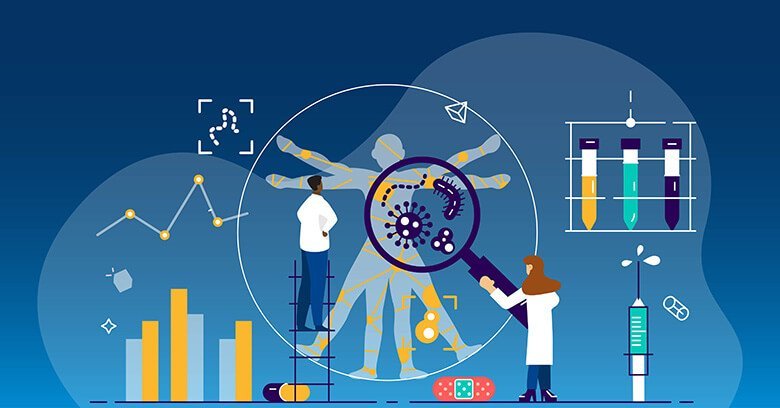Since March of 2020, the concept of public health has taken on new meaning. People all over the world are more aware than ever of health trends and how they might be affected by them. In this state of anxiety and curiosity, the public has been more interested in ever than the processes that educate and protect them.
Biostatistics has been around since long before Covid-19, and yet it seems so uniquely appropriate for the moment that we are in, bringing the age of information and data into the post-Covid world.
In this article, we look at what biostatistics are, and how they can identify and influence health trends.
First, What is Biostatistics?
Biostatistics is a broad field that essentially refers to any process in the world of medicine in which data is used to establish knowledge. Information could be harvested from medical records, patient surveys, public health reports, and even observation.
For example, a biostatistics-driven study in 2011 identified that patients suffering from a specific back condition did not benefit at all from epidurals, even though this had previously been one of the default treatments for pain relief.
The result? Epidurals were no longer used, and patients and hospitals alike saved time and resources. As healthcare professionals and scientists gain more access to statistics, the capacity for biostatistics to do its work will only increase. Genome testing is expected to be a big boon in helping scientists understand what genetic qualities make people more predisposed to getting sick.
Biostatistics can even be used to determine how likely a person is to survive treatment. Naturally, these are all vital, even if distant developments. However, as Covid-19 demonstrated very clearly, biostatistics can also play a large role in identifying public health trends.
Vaccination Records
Using local vaccination records scientists can establish a correlative relationship between immunization and infection. For example, if a biostatistical analysis were to identify that a region of the country that is Flu vaccine reluctant also happens to have very high rates of the flu, this information could be distilled into reports that the community members can then use to make more informed health decisions going forward.
The role of biostatistics is not necessary to establish specific health recommendations. As a statistical-based practice, it simply compiles information which is then processed until actionable insights can be derived.
For the community with high rates of the flu, this may mean a high concentration of public awareness campaign materials explaining the situation and encouraging people to do what they can to slow the spread of infection.
Obesity
Not only public health concerns are viral. Covid-19 demonstrated that biostatistics has the potential to work in a very immediate capacity. But what about conditions that burn slowly over time? Obesity is a good example.
The rate of overweight or obese children has skyrocketed over the past fifty years, turning what had once been called “Adult-onset” diabetes, into the newly reminted “Type Two Diabetes”.
Biostatistics can:
- Identify health concerns that emerge from obesity: For example, data-driven reporting has established that obese people of an advanced age are significantly more likely to experience sudden death than people who are a healthy weight. It has also established a causal relationship between cardiovascular distress and obesity in children. With detailed, granular insights, biostatistics provide very specific information on what happens when people reach an unhealthy weight.
- Spotlight lifestyle factors that increase or decrease the risk of obesity: The same statistical reports that identify the risks of obesity can also identify lifestyle commonalities amongst obese people. For example, these reports might be able to describe how many grams of fat or calories obese people eat on average. It might also provide insights into the correlation between being sedentary and obese.
This information can be used to make more specific lifestyle recommendations to people who want to keep their weight in check.
Knowing all of this, biostatistics can anticipate the onset of obesity-related illness that the next generation will experience if rates of unhealthy weight gain continue in the direction they are currently on.
Not only does this information make it easier for doctors to provide high-quality preventative care, but it also equips patients with the knowledge they need to take their health into their own hands.
Viral Awareness
In the context of Covid-19, statistics have been used to predict surges, and provide communities with estimates for when they would hit their peeks. More specifically, biostatistics can examine what happened in one community, and make reasonable predictions about what would happen in another, similar community.
For example, if City A has a concentration of 1 million people, and City B has that same number living on approximately the same amount of land, a statistician could make reasonable predictions about the rate infection would spread in one community by looking at what took place in the other.
As Covid-19 often showed, there is a lot of subjectivity that statistics can’t always capture. Estimates won’t necessarily come to fruition. However, they can inform personal decisions, and help politicians draft regulations that are designed to prevent the spread.
In times of crisis, biostatistics come in with the clarity of fact, providing information that can save lives, and give doctors and patients alike a sense of control over a situation that might otherwise feel helpless.
Conclusion
Biostatistics is doing a lot for public health, but the future has the potential to be brighter yet. Covid-19 has led to increased interest and receptiveness to information about public health. This, coupled with the modern world’s ever-increasing ability to process and comprehend enormous caches of data makes now as good of a time as ever for biostatistics to produce meaningful insights with long last implications. Now is a great time to consider a career in biostatistics. Not only is the profession in high demand, but professionals enjoy stimulating work in a career path that boasts an above-average medium income.

